Heng Cai
Toward building next-generation Geocoding systems: a systematic review
Mar 24, 2025Abstract:Geocoding systems are widely used in both scientific research for spatial analysis and everyday life through location-based services. The quality of geocoded data significantly impacts subsequent processes and applications, underscoring the need for next-generation systems. In response to this demand, this review first examines the evolving requirements for geocoding inputs and outputs across various scenarios these systems must address. It then provides a detailed analysis of how to construct such systems by breaking them down into key functional components and reviewing a broad spectrum of existing approaches, from traditional rule-based methods to advanced techniques in information retrieval, natural language processing, and large language models. Finally, we identify opportunities to improve next-generation geocoding systems in light of recent technological advances.
3D Medical Image Segmentation with Sparse Annotation via Cross-Teaching between 3D and 2D Networks
Jul 30, 2023



Abstract:Medical image segmentation typically necessitates a large and precisely annotated dataset. However, obtaining pixel-wise annotation is a labor-intensive task that requires significant effort from domain experts, making it challenging to obtain in practical clinical scenarios. In such situations, reducing the amount of annotation required is a more practical approach. One feasible direction is sparse annotation, which involves annotating only a few slices, and has several advantages over traditional weak annotation methods such as bounding boxes and scribbles, as it preserves exact boundaries. However, learning from sparse annotation is challenging due to the scarcity of supervision signals. To address this issue, we propose a framework that can robustly learn from sparse annotation using the cross-teaching of both 3D and 2D networks. Considering the characteristic of these networks, we develop two pseudo label selection strategies, which are hard-soft confidence threshold and consistent label fusion. Our experimental results on the MMWHS dataset demonstrate that our method outperforms the state-of-the-art (SOTA) semi-supervised segmentation methods. Moreover, our approach achieves results that are comparable to the fully-supervised upper bound result.
Orthogonal Annotation Benefits Barely-supervised Medical Image Segmentation
Mar 23, 2023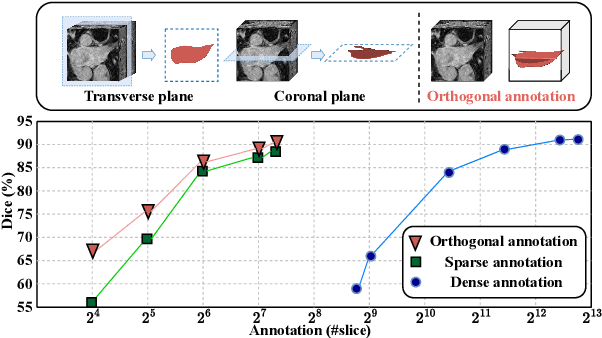
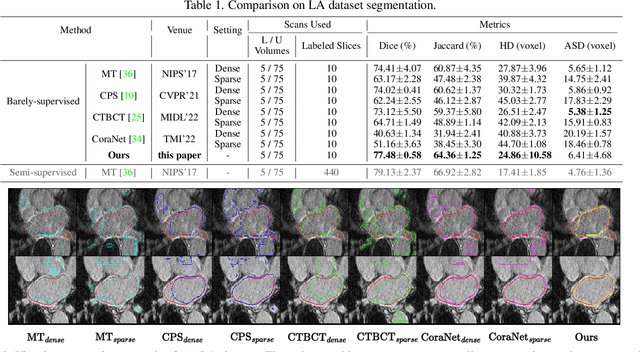
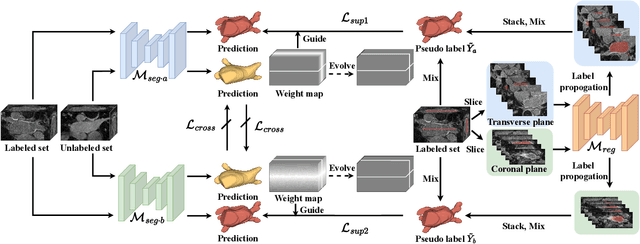
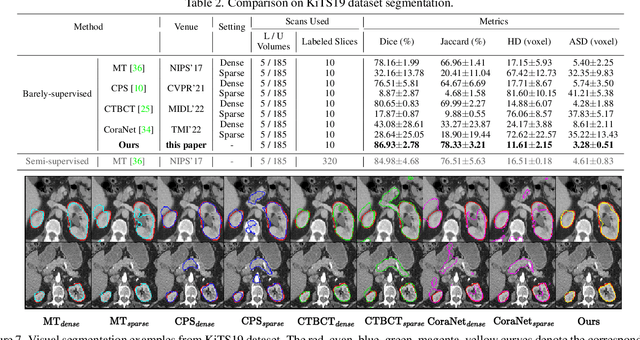
Abstract:Recent trends in semi-supervised learning have significantly boosted the performance of 3D semi-supervised medical image segmentation. Compared with 2D images, 3D medical volumes involve information from different directions, e.g., transverse, sagittal, and coronal planes, so as to naturally provide complementary views. These complementary views and the intrinsic similarity among adjacent 3D slices inspire us to develop a novel annotation way and its corresponding semi-supervised model for effective segmentation. Specifically, we firstly propose the orthogonal annotation by only labeling two orthogonal slices in a labeled volume, which significantly relieves the burden of annotation. Then, we perform registration to obtain the initial pseudo labels for sparsely labeled volumes. Subsequently, by introducing unlabeled volumes, we propose a dual-network paradigm named Dense-Sparse Co-training (DeSCO) that exploits dense pseudo labels in early stage and sparse labels in later stage and meanwhile forces consistent output of two networks. Experimental results on three benchmark datasets validated our effectiveness in performance and efficiency in annotation. For example, with only 10 annotated slices, our method reaches a Dice up to 86.93% on KiTS19 dataset.
Zero and R2D2: A Large-scale Chinese Cross-modal Benchmark and A Vision-Language Framework
May 08, 2022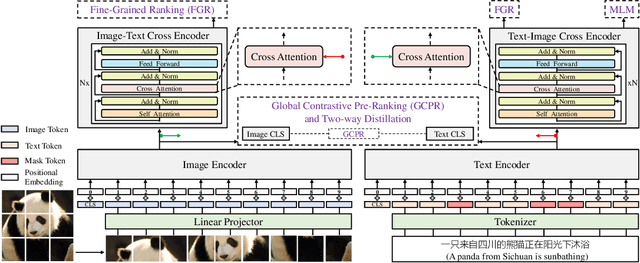
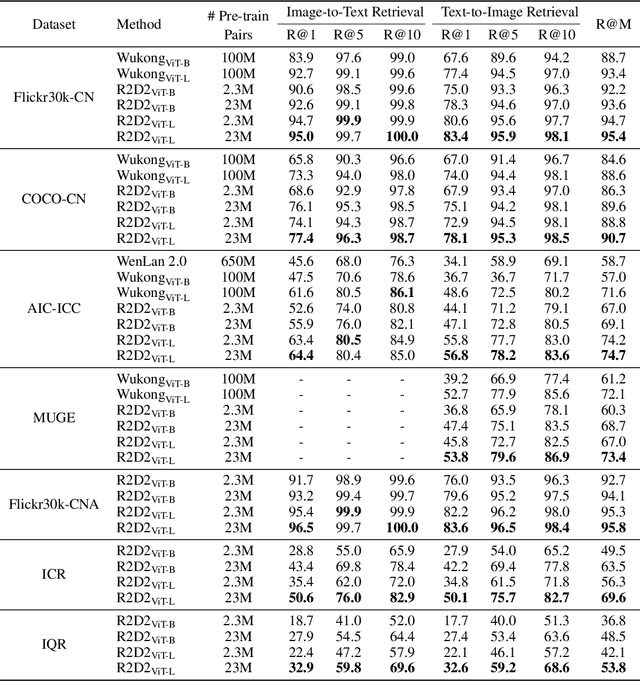
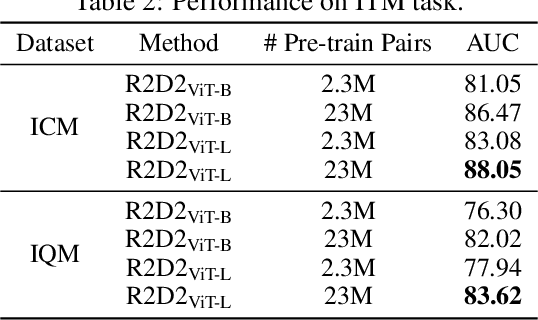
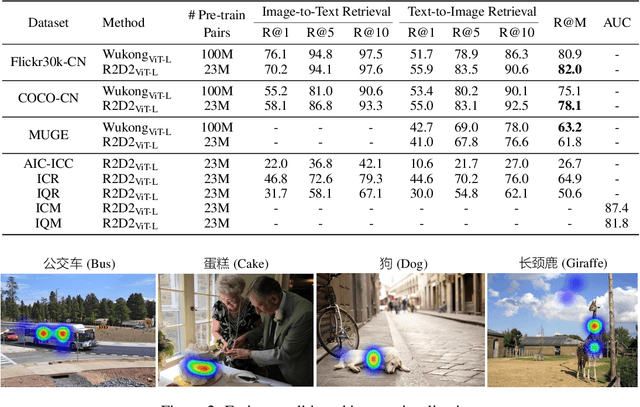
Abstract:Vision-language pre-training (VLP) relying on large-scale pre-training datasets has shown premier performance on various downstream tasks. In this sense, a complete and fair benchmark (i.e., including large-scale pre-training datasets and a variety of downstream datasets) is essential for VLP. But how to construct such a benchmark in Chinese remains a critical problem. To this end, we develop a large-scale Chinese cross-modal benchmark called Zero for AI researchers to fairly compare VLP models. We release two pre-training datasets and five fine-tuning datasets for downstream tasks. Furthermore, we propose a novel pre-training framework of pre-Ranking + Ranking for cross-modal learning. Specifically, we apply global contrastive pre-ranking to learn the individual representations of images and Chinese texts, respectively. We then fuse the representations in a fine-grained ranking manner via an image-text cross encoder and a text-image cross encoder. To further enhance the capability of the model, we propose a two-way distillation strategy consisting of target-guided Distillation and feature-guided Distillation. For simplicity, we call our model R2D2. We achieve state-of-the-art performance on four public cross-modal datasets and our five downstream datasets. The datasets, models and codes will be made available.
 Add to Chrome
Add to Chrome Add to Firefox
Add to Firefox Add to Edge
Add to Edge